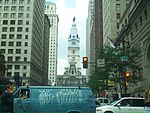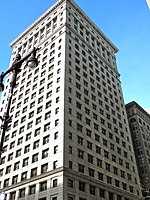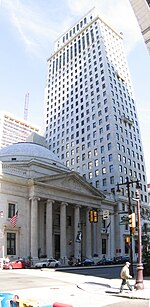Broad Street (Philadelphia)

Broad Street is a major arterial street in Philadelphia, Pennsylvania. The street runs for approximately 13 miles (21 km), beginning at the intersection of Cheltenham Avenue on the border of Cheltenham Township and the West/East Oak Lane neighborhoods of North Philadelphia to the Philadelphia Navy Yard in South Philadelphia. It is Pennsylvania Route 611 along its entire length with the exception of its northernmost part between Old York Road and Pennsylvania Route 309 (Cheltenham Avenue) and the southernmost part south of Interstate 95. Broad Street runs along a north–south axis between 13th Street and 15th Street, containing what would otherwise be known as 14th Street in the Philadelphia grid plan. It is interrupted by Philadelphia City Hall, which stands where Broad and Market Street would intersect in the center of the city. The streets of Penn Square, Juniper Street, John F. Kennedy Boulevard, and 15th Street form a circle around City Hall at this point. It is one of the earliest planned streets in the United States, and is listed on the National Register of Historic Places as a continuous north–south street, planned by surveyor Thomas Holme and developed for Philadelphia in 1681.Broad Street is served by many public transit routes, including SEPTA's Broad Street Line subway and several SEPTA City Bus routes.
Excerpt from the Wikipedia article Broad Street (Philadelphia) (License: CC BY-SA 3.0, Authors, Images).Broad Street (Philadelphia)
Underground Concourse, Philadelphia Center City
Geographical coordinates (GPS) Address Nearby Places Show on map
Geographical coordinates (GPS)
| Latitude | Longitude |
|---|---|
| N 39.950827 ° | E -75.163968 ° |
Address
Underground Concourse
Underground Concourse
19110 Philadelphia, Center City
Pennsylvania, United States
Open on Google Maps






